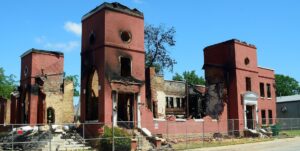
Moving Forward: CA’s Community Colleges and Economic Recovery
Mask-wearing, rising vaccination rates, and a growing pool of COVID-19 survivors are indications that the Los Angeles region is moving closer to ‘re-opening’ and returning to however that ‘new normal’ might look. The Governor is stepping up to support the momentum by heavily investing public dollars in workforce and employment recovery activities. At the top of his ‘California Comeback Plan‘ prioritization is tightening the relationship between California’s community colleges (CCCs) and its Labor and Workforce Development Agency. The investments recognize the value of encouraging industry participants to inform workforce training and education decisions. Through these partnerships, the industry-building efforts of both – the business and its future employees – start and continue on the same page. And informing the actions of the emerging collaboration is the High Road Training Partnerships (HRTP) initiative.
Follow the Money
In his ‘Comeback Plan’ proposal, Governer Newsom includes $157 million to build out the HRTP infrastructure. While building on existing business/CCC relationships, the initiative also embraces social and cultural elements emerging as the COVID-19 pandemic and roiling social concerns reveal them. Three specific challenges – Equity, Climate, and Jobs (the ECJ Initiatives) – impede forward momentum by both the State and its residents:
Economic Inequities – California’s communities of color and those with differing abilities or characteristics have borne much of the brunt of economic declines driven by the pandemic. In addition, discrimination against gender, race, or social ‘status’ erodes both personal and community resources, leaving everyone poorer in the process.
Climate Change Realities – While endeavors continue to slow the progress of adverse climate change, efforts to build in resilience to its impacts are also critical for the future economic success of the State and its residents. In California, higher temperatures, less rainfall, wildfires, etc., create challenging environmental situations in the areas least able to withstand them. Communities that don’t have access to ameliorating resources (like air conditioners) or are situated in geographical areas that are more innately hazardous (located closer to pollution-emitting sites).
Job Quality Concerns – Underpaid and under-represented workers have also suffered unnecessarily excessive losses over the past several years. Employees who don’t receive healthcare benefits, don’t have union connections, or aren’t paid a ‘living wage’ despite full-time employment are more likely to have suffered more and more adverse health and economic challenges since the onset of the coronavirus concern, and, in most cases, for years or even decades.
All of these factors adversely affect all of California’s industries. The HRTP is already establishing partnerships with key participants in eight industrial sectors as a launch to the ‘high road’ industry/CCC collaborations needed in each: logistics, janitorial, healthcare, hospitality, the Port system, the public sector, public transportation, and water management. California’s leaders now realize that resolving the economic challenges driven by these factors will contribute immensely to California’s recovery from the pandemic while also addressing decades-old injustices that have hobbled its progress.
LA County Realities
With its enjoyable climate, strong industrial base, and encouragement of innovation, Los Angeles County supports thousands of businesses that generate billions of dollars every year. Unfortunately, the COVID-19 pandemic caused stoppages and delays in all of its industries, which seriously eroded the County’s economy and that of each of its residents. Recovering from those negative impacts will require innovation and collaboration amongst all its stakeholders, including its individual businesses and its 47 community colleges.
While the Governer’s Comeback Plan provides a framework for building the future economy, the COVID-19 situation will also continue to impact – and sometimes delay – forward movement. CDC COVID-19 guidance and protocols from LA County continue to control re-opening efforts for all of its community colleges. Because an independent Board of Governors governs each school, each school will make its own ‘re-opening’ decision. All, however, remain subject to overarching state-issued rules:
Until more vaccinations are received, the mandate for maintaining social distancing and mask-wearing standards remains. As of June 10, 2021, LA County ranked 70th of 584 counties for its high number of COVID-19 cases per 100,000 residents (12,409). Also as of that date, the County had fully vaccinated 55% of its residents aged 16+, with an additional 10% having received at least one dose. Millions remain unvaccinated, however.
Those schools that choose to open in-person classes and events must limit attendance to 50% capacity and adhere to rules governing informal social gatherings.
The housing of students on-campus can resume within specified density and cleaning parameters.
Entry screening and exposure containment rules guide actions to reduce exposure to the virus as well as appropriate responses when it is detected on campus.
With summer’s arrival and the Fall ’21 term imminent, all LA County community colleges and their constituents must comply with COVID-19 limitations, rules, and protocols.
Pasadena Realities
The City of Pasadena continues to evolve its protocols and practices as COVID-19 waxes and wanes within its borders. While also encouraging everyday precautions such as hand-washing and mask-wearing (following California’s June 15 mask-wearing guidelines), in early May, the City also lowered its ‘risk’ level to the ‘Yellow Tier.’ Most businesses can open for customers up to a 50% capacity at this tier, although physical distancing protocols remain in place. In addition, indoor gatherings, including those occurring at Pasadena area colleges, are subject to additional restrictions that include limitations on the number of guests per facility capacity, restrictions on food and beverage consumption, and ventilation requirements.
At Pasadena City College, the Board of Directors continues to evaluate situational realities, so the protocols put in place for the Spring 2021 term remain in effect until further notice. The school’s COVID-19 Transition Task Force has issued a series of recommendations for the criteria that will guide safe re-opening procedures to protect the health and safety of all of PCC’s constituents. In the meantime, PCC staff and students who intend to return to the school in person for any reason must follow Current Campus Access practices. And there’s a new FAQ web page to help everyone assess the School’s COVID-19 related activities to determine if those impact a personal sense of risk or safety.
The COVID-19 pandemic has caused an irreversible change on everything from the Governor’s Office down to a PCC student’s backpack. As the State, the County, the City, and the School look to resuming ‘normal’ operations, everyone must do their part to reduce and contain the spread of the disease. By doing so, they not only improve the odds that their lives will soon return to ‘normal,’ but they’ll also play a role in getting California back on its economic feet and maximize the Governor’s investment in its community colleges.


